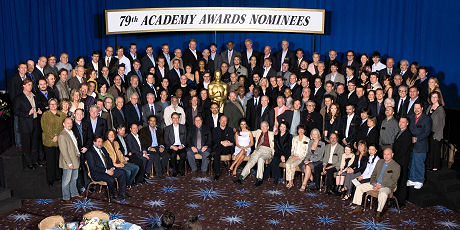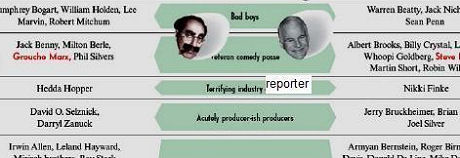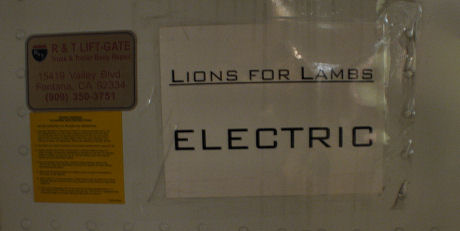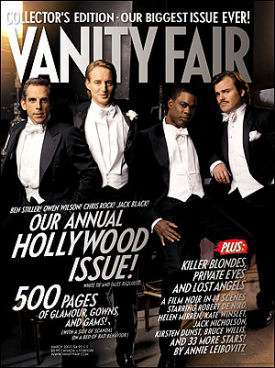“Moody and unpredictable, Jim Carrey has long been one of the world’s most bankable actors,” reads the headline copy for Kim Masters‘ just-published Radar magazine hit piece. “But last year, as reports of his bizarre behavior and on-set tantrums circulated through Hollywood, several of his major projects imploded. Has America’s class clown soured on the shtick that made him famous? Or have the studios soured on him?”
No connections
Dreamgirls fails to land a Best Picture and Best Director nomination, and two weeks later the two biggest publicity people on the Dreamamount lot — Nancy Kirkpatrick and Eric Kops — announce they’re leaving to start their own firms. On top of Dreamgirls Oscar strategist Terry Press announcing the same thing two or three weeks earlier. But there’s absolutely no connection, I’m told. Kops wants to produce, not publicize, and Kirkpatrick has been rumored to be exiting her post since Sherry Lansing left the lot.
Gore will be presdient?
“Former vice-president Al Gore will be the next president of the United States,” the Toronto Star‘s “Oscarology” blogger Peter Howell has declared. “Why? Because on Feb. 25 he’s going to win the Oscar for Best Documentary Feature for An Inconvenient Truth, his expose about global warming that is having a big impact on the global village consciousness.
“Gore is on the side of the angels and of history with this issue, and he’s been leading the charge. Wiser political minds than mine insist that Hillary Clinton, Obama Barack or John Edwards will be the next president. I say the three are just worthy contenders for the crown, which will ultimately be placed on the head of Gore.
“Global warming has become the issue of current times, replacing global terrorism as the nightmare scenario. Gore offers hope and action. Just ask the people who hand out the Nobel Prizes, whom this week nominated Gore for a Nobel Peace Prize for his efforts to save the planet.
“The guy could have both an Oscar and a Nobel this year. A perfect way to launch a campaign for a presidential race you know he’s going to enter, despite all the non-denial denials. He’s being smart and letting Clinton, Barack and Edwards tear themselves apart before committing. But he will. And he will win.”
Oscar nominees

All together now — the whole Oscar nominee community at the same instant in the same cosmic space, taken before or after Monday’s Oscar nominee luncheon. USA Today reporter Claudia Puig says “the biggest cheers were heard for director Martin Scorsese, Will Smith, Forest Whitaker, Abigail Breslin, Helen Mirren and Peter O’Toole, who got a standing ovation.”
Lane on “Others”
New Yorker critic Anthony Lane‘s review of The Lives of Others is one of his best ever — eloquent, compassionate and appreciative of every last echo in this awesomely fine film.
“If there is any justice, this year’s Academy Award for best foreign-language film will go to The Lives of Others, a movie about a world in which there is no justice,” he begins. “It marks the debut of the German director Florian Henckel von Donnersmarck, of whom we have every right to be jealous. First, he is a stripling of thirty-three. Second, his name makes him sound like a lover with a duelling scar on his cheekbone in a nineteenth-century novel. And third, being German, he has an overwhelming subject: the postwar sundering of his country.
“For us, the idea of freedom, however heartfelt, is doomed to abstraction, waved by politicians as if they were shaking a flag. To Germans, even those of Donnersmarck’s generation, freedom is all too concrete, defined by its brute opposite: the gray slabs raised in Berlin to keep free souls at bay.”
The final scene, he says, is one “of overwhelming simplicity and force, in which the hopes of the film — as opposed to its fears, which have shivered throughout — come gently to rest. What happens is that a character says, ‘Es ist fur mich’ — ‘It’s for me.’ When you see the film, as you must, you will understand why the phrase is like a blessing. To have something bestowed on ‘me’ — not on a tool of the state, not on a scapegoat or a sneak, but on me — is a sign that individual liberties have risen from the dead.
“You might think that The Lives of Others is aimed solely at modern Germans — at all the Wieslers, the Dreymans, and the weeping Christa-Marias. A movie this strong, however, is never parochial, nor is it period drama. Es ist fur uns. It’s for us.”
VF trashes Finke
There’s a two-page “Vanities” chart in Vanity Fair‘s just-out Hollywood issue, comparing the earmarks of Old Hollywood with Old New Hollywood. On the second page Hedda Hopper and Deadline Holly- wood Daily‘s Nikki Finke are equated as the old and new versions of “terrifying industry gossip.” Except Nikki pasted over the word “gossip” on her site and changed the term to “reporter.”

I can sympathize with the paste-over impulse. Finke is a hybrid columnist of some kind, but there’s no doubt that she makes the calls and digs into the particulars like any hard-boiled reporter. She makes judgment calls and says what she thinks deep down, but her column wouldn’t be what it is without her sources, her note pad and old-fashioned shoe leather.
AMPAS vs. Sasha Stone
Sasha Stone‘s Oscarwatch.com has covered the Oscar scene with class, insight and relentless energy for seven and a half years. She has done more to create a sense of curiosity, suspense and respect for the annual Academy Awards show than the nominations and awards themselves have warranted. Plus she’s a struggling overworked mom who isn’t getting rich off this endeavor. But at least until last week, Academy attorneys had allowed her use the name “Oscar” on her site without acting like insensitive bullies.

No longer. Last week AMPAS lawyers ordered Stone to give up the “Oscarwatch” name or face a lawsuit.
Why the sudden turnaround? Because they read in Stephen Rodrick‘s Los Angeles magazine piece about Oscar bloggers (“The Blog Whisperers”) that Stone makes a piddly $20 grand a year from Oscarwatch.com ad revenues. Being the owners and absolute rulers of the Oscar trademark, they don’t want people profiting from using the name in any kind of commercial venture.
The Academy attorneys are pricks, but they have a point. Stone will probably have to knuckle under and rename her site www.awardsdaily.com, or something along those lines. She should ideally call it www.sashastone.com, but somebody owns that URL, she says. But there’s no website using that name so maybe she can purchase it.
An attorney friend has told me Stone should fight this tooth and nail. “I just don’t like the idea of a huge corporate entity pushing this little journalist around,’ he said. ‘She could probably keep the name if she removed that Oscar trademark ‘r’. The site’s slogan says ‘nobody knows anything’ — maybe if she added ‘an independent Oscar site’ she might be able to keep the name. The bottom line is an issue of people confusing Oscarwatch with the official Oscar site. This could be finessed.
“People are using the word ‘Oscar’ all over the place. They use it in news articles, columns…everywhere. The term ‘Oscar Watch’ is used by the Hollywood Reporter, I think. The usage is obviously everywhere, but they’re pouncing on Sasha Stone because they read in a magazine article that she earns enough ad money to pay the rent for her apartment and buy her daughter some clothes on EBay and buy some food staples at Costco.”
Even if she finally has to surrender the Oscarwatch.com domain name, Stone should fight and stall as much as she can because she needs all the time she can get in order to thoroughly spread the word around about the new site name, whatever it might be.
I think my attorney friend is right. I think is a solvable, finessable situation. If there are any trademark attorneys out there would like to help Stone on a pro bono basis, I’ll do everything I can to make sure that their law practice gets a fair amount of professional attention from the entertainment community.
Scott Martelle‘s Envelope/L.A. Times piece about Stone’s legal troubles says that the Academy “has taken similar measures dating back a decade, including moving in 2000 against some 50 websites that incorporated Oscar or Academy in their site names. But this is the first time the Academy has gone after Stone’s site.
“Stone speculated she was targeted to preclude other potential users of ‘Oscar’from citing her as an example in challenging the Academy’s trademark. Yet the name is already part of the common language, she said.
“‘I really do think I can argue this thing — people do use the name all the time Oscarwatching is its own word, really. But I probably just can’t afford it. I think I’ll just have to comply.” Again — some attorney needs to help this lady out.
Lions for Lambs

Robert Redford’s Lions for Lambs was shooting last week at Lucques on Melrose, right down the street from my place. The United Artists release, due next year, costars Tom Cruise, Meryl Streep, Redford, Derek Luke and Michael Pena.
Thompson’s Murphy comment
“Mark my words, if Eddie Murphy doesn’t win on Oscar night, it’s because someone worked very hard to take it away from him.” — Anne Thompson writing yesterday on Riskybiz blog. In other words, there’s no way a sizable block of voters might decide on their own that Murphy’s Dreamgirls role and his performing of it aren’t that awesome, or that they simply feel more respectful and supportive of Alan Arkin this year? And there’s no way to express doubts about Murphy’s Oscar worthiness without being a hater and a smear-ist?
Huffington on Obama
Barack Obama “is young, brilliant, handsome, charismatic…and, yes, Senator Biden, ‘clean as a whistle,'” Arianna Huffington wrote yesterday. “But the reason why Hollywood has gone ga-ga for Obama can be summed up in one word: casting. In Hollywood, it’s the key to greenlighting a movie; it can make or break one (if you don’t believe me, put someone other than Will Smith in The Pursuit of Happyness and see if it makes over $150 million domestic).
“As much as we may not want to admit it — as much as we may wish that politics was about policies and the perfect health care plan — the truth is unavoidable: casting matters. It matters very much. And it’s not just a question of finding someone with ‘star quality,’ a young, handsome leading man to head your ticket (if that were the case, Brad Pitt would be president — and our first lady a lot more interesting). It’s about blending the right candidate with the right role at the right time for our country.
“For a long time now, America has been besotted with the idea of President as Macho Cowboy. Think John Wayne. Or Ronald Reagan epitomizing the John Wayne archetype. The tough-talking, straight-shooting, no-crap-taking role model has captured the public’s fancy — especially in a post-9/11 world.
“It’s one of the reasons Bush was able to win reelection despite all the massive failures of his first term. He was seen as a brush-clearing, pick-up-driving, big-belt-buckle-wearing, terrorist-ass-kicking kind of guy. The sort of fellow you could have a beer with, as opposed to John Kerry‘s equivocating, wind-surfing, Chardonnay-drinking persona.
“But after six years of Bush’s all-hat-no-cattle leadership, the American public seems ready to abandon the John Wayne fantasy. The question is: to be replaced by what? A Jimmy Stewart-style Everyman? An honest-as-the-day-is-long Gary Cooper type? A Gregory Peck-does-Atticus Finch moralist?
“With his moral sense of social responsibility and his ‘audacity of hope’ optimism, Obama may help the country leave behind John Wayne and embrace Atticus Finch. The man and moment may be made for each other.”
Halbfinger on H’wood fund-raising
“And after months of debating Cuaron vs. Inarritu vs. Almodovar, Eastwood vs. Eastwood, and Dreamgirls vs. The Departed, the burgeoning Democratic presidential field has given the film community something more to debate than who will win a statuette.
“‘Politics has come back, and with a huge thrill,’ said Irena Medavoy, wife of the movie producer Mike Medavoy, who has vowed to raise $100,000 for Senator Barack Obama, the Illinois Democrat, with an event at her home in March. (Her husband is neutral as yet.)
“What√ɬ¢√¢‚Äö¬¨√¢‚Äû¬¢s more, she said, the fund-raising sprint gives Hollywood people a chance to speak out without fear of a backlash, a window that will eventually close. ‘Right now we can raise money and talk about the issues,’ Ms. Medavoy said. ‘In 2008 we√ɬ¢√¢‚Äö¬¨√¢‚Äû¬¢ll have to shut up again, because not only does Hollywood not matter, but you can hurt your candidate.'” — from David Halbfinger‘s N.Y. Times story about the Hollywood fund-raising frenzy among Presidential contenders.



